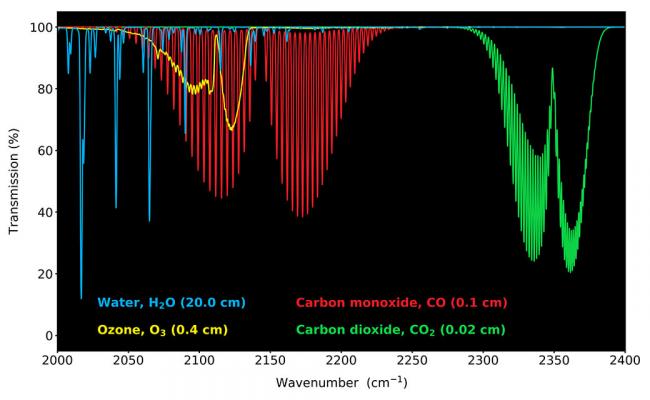HITRAN and HITEMP Database
With techniques developed in quantum mechanics, molecular spectra can be modeled by a set of discrete fundamental parameters. The knowledge of these reference molecular spectroscopic parameters is essential to correctly characterize constituents of their environments, model their spectra and atmospheric conditions. Physicists at the Center for Astrophysics | Harvard & Smithsonian maintain the HIgh-resolution TRANsmission (HITRAN) and HIgh TEMPerature (HITEMP) databases of molecular spectral parameters, along with the HITRAN Application Programming Interface (HAPI) which also enables one to access the database archive and process the data.

Calculated transmission spectra (in small spectral range around 5 µn) through four sample cells containing one atmosphere of each of selected HITRAN molecules at 296 K with the corresponding path length in parentheses. Spectra have been calculated using the HITRAN2016 database and HAPI python libraries.
Essential Knowledge for Professional Astronomers
The details of how molecules absorb and emit light depend on environmental factors, which may be strikingly different than conditions on Earth. When astronomers need to identify these molecules in other places — the atmospheres of exoplanets, for example — they need detailed spectroscopic references to compare with observational data. These reference spectroscopic parameters also allow them to infer details about the system under observation, including the temperature, climate, and other environmental conditions.
The roots of HITRAN go back to the 1960s, when researchers began compiling the details of infrared spectra for major absorbers of light in the terrestrial atmosphere. Since then, the database has been expanded to include spectral parameters for many trace gases of terrestrial and planetary atmospheric interest in microwave, infrared, visible, and ultraviolet regions. As an example, HITRAN includes spectroscopic data for important organic molecules and pollutants in the terrestrial atmosphere, which are paramount for interpreting Earth observation experiments. The project website also hosts Python code for accessing the database and carrying out sophisticated calculations.
Another aspect of HITRAN is that when highly-detailed spectral parameters are not currently available either from controlled laboratory measurements or theory, experimentally-determined cross-sections (intensity vs frequency) at different temperatures and pressures are provided. There are almost 300 molecules represented in that manner. The disadvantage of the cross-sectional approach is that it is harder to extrapolate/interpolate to different temperatures and pressures.
The database provides spectral data not only for individual molecules but also for many collision complexes (collision-induced absorption) that form under atmospheric pressures. Additionally, HITRAN includes spectral data on aerosols: solid particles or droplets of liquids suspended in planetary atmospheres.
The database releases quadrennial editions described in associated papers which are among the most cited references in geophysics. The latest edition of the database is HITRAN 2016.
As of February 2020, there were over 15,000 users registered on hitran.org.
The spectra of molecules change with temperature. In the “hot” atmospheres of stars, brown dwarfs, and many exoplanets, substantially more rotational and vibrational energy levels are populated than at terrestrial temperatures, and therefore more transitions (by orders of magnitude) are required. For these environments, the HITRAN project hosts an additional database called HITEMP which features significantly more transitions for selected molecules.
The spectral data in HITRAN and HITEMP are based on sophisticated calculations and laboratory experiments, in order to provide high-resolution spectra for observers to use. HITRAN provides the reference sources for the key parameters (as well as their uncertainties) within each transition whereby the user can determine from where the value originated and consult original sources for details.
When new spectral parameters become available, they are evaluated and, if it is determined that they provide a better agreement between calculated spectra and observed spectra, they are incorporated into the database archive.
Another database maintained at the Center for Astrophysics is AtomDB which provides a resource for X-ray atomic spectra.
Experts
- Laurence Rothman
- Iouli Gordon
- Frances Skinner
- Robab Hashemi
- Ekaterina Karlovets
- Eamon Conway
- Artem Finenko
- Robert Hargreaves